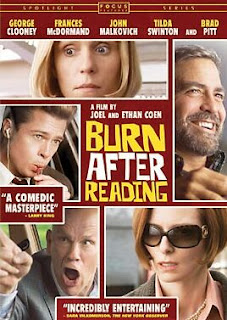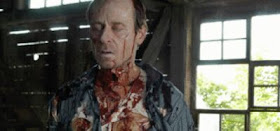Originally posted on 11/17/19
One thing 50s and 60s television did so well, and which seems to have been lost these days, was the powerful half-hour drama. This is especially true of the better written and produced anthology shows of the time, including the hardboiled, often riveting journalism drama "Deadline."
Film Chest's new 3-disc, 39-episode DVD collection DEADLINE ("When Reporters Were Heroes") contains the entire run of the show (which aired sporadically from 1959 to 1961), with each episode covering various true-life news stories and the dogged reporters who unearthed them, often putting their lives in jeopardy to do so.
Paul Stewart (CITIZEN KANE) lends the show a distinguished air as the gravel-voiced host who, while sitting in a busy newsroom amidst diligent reporters and other workers, introduces each front-page story and the journalist who broke it.


Most of the stories are crime-related, as the reporters often work alongside police detectives on cases involving murder, robbery, arson, kidnapping, extortion, prison riots, mad bombers, juvenile delinquency, shoplifting, and political corruption.
The reporters track down leads and confront bad guys like hardnosed cops, sometimes giving the show the feel of a "Dragnet" episode. The low budget and abundance of location shooting in the heart of the city also give it a gritty, realistic look. (Listen for some familiar "Plan 9 From Outer Space" library music within the show's score.)
Some stories are particularly powerful, as when a man (actor/director Mark Rydell) is accused of planting a bomb in his mother's suitcase and killing an entire planeload of people for her insurance money. In another, a college student's thesis on how to commit the perfect murder is tested with the cold-blooded killings of two innocent men.
In addition to these subjects are the ones more related to human interest and social justice, with the reporters often being portrayed as crusading angels and pillars of moral virtue. Indeed, the series goes to great lengths to dispel any popular notions regarding the profession which are anything but positive.
Here we witness stories of amateur spelunkers being rescued from a cave (a very young Christopher Walken is billed as "Ronnie"), a pair of Burmese nurses being saved from deportation by a reporter (Frank Sutton, "Gomer Pyle, U.S.M.C.") whose life they once saved in a makeshift army hospital, and another reporter going undercover to expose the exploitation of illegal immigrants on the U.S.-Mexico border. There's even a heart-tugging Christmas episode.
The stories are lean, terse, and to the point. They're also somewhat addictive, making them good binge-watching material for those so inclined. Like many anthology shows of the time, "Deadline" was a place for writers and actors to hone their talents, often doing work that is inspired.
The film quality of these black and white episodes is generally pristine save for occasional rough spots, which I think only add to their character. According to the promo information, these films were lost and forgotten in a garage in New Jersey for over 50 years before rediscovery.
Stewart himself plays the lead in many of the episodes. Other familiar faces include Telly Savalas, Peter Falk, Simon Oakland, Malachi ("Mal") Throne, Diane Ladd, Joanne Linville, Robert Lansing, George Maharis, Sydney ("Sidney") Pollack, Bibi Osterwald, Frank Overton, Lee Bergere, Jan Miner, Bob Hastings, Walter Brooke, Dana Elcar, Lonny Chapman, Jason ("Herb") Evers, Micheal Conrad, and Alfred Ryder.
As mentioned, the show glorifies the reporter's role as a crusader for justice and defender of all that is good, vowing (also quoting the promo info) to "uphold everything that our civil society stands for."
The text material found in the enclosed episode-guide booklet stresses how tarnished the reporter's image has become in recent years, blaming this not on any failing on the part of today's mainstream media but on its being undermined by alleged "fake news" being spread by the internet and other independent sources.
I find this either willfully naive or intentionally misleading, considering the fact that, in recent years, major print and television news sources seem to have relinquished a great deal of their former integrity while much of the actual truth one is able to glean these days does, in fact, come from the internet.
Not only that, but the booklet's text as well as a DVD interview with a noted broadcast journalism professor seem to be just as politically biased as is much of today's mainstream media.
Putting such gripes aside, however, DEADLINE is a rich source of entertainment for vintage TV lovers, and Film Chest has done a fine job of preserving and presenting these exciting episodes that are such a valuable part of television history.
BONUS FEATURES
Episode Synopses • Photo Gallery • Trailer •
Trivia • Extended Synopsis: Journalism Past and
Present Overview • Interview with Broadcast
Journalism Professor Joe Alicastro
SKU: FC-647
UPC: 874757064796
SRP: $19.98
Street Date: 11/19/2019
Pre-Book: 11/5/2019
Discs: 3
Box Lot: 30
Production: Arnold Perl
Run Time: 1,006 Mins
Format: DVD
Color/B&W: B&W
Aspect ratio: 4x3
Year Prod: 1959 - 1961
Sound: Mono
Studio: Film Chest
Rating: Not rated
Genre: Television, Crime, Drama
Actor(s): Paul Stewart (narrator), Peter Falk,
Diane Ladd, George Maharis, Robert Lansing
and many more.
Director(s): Various











































